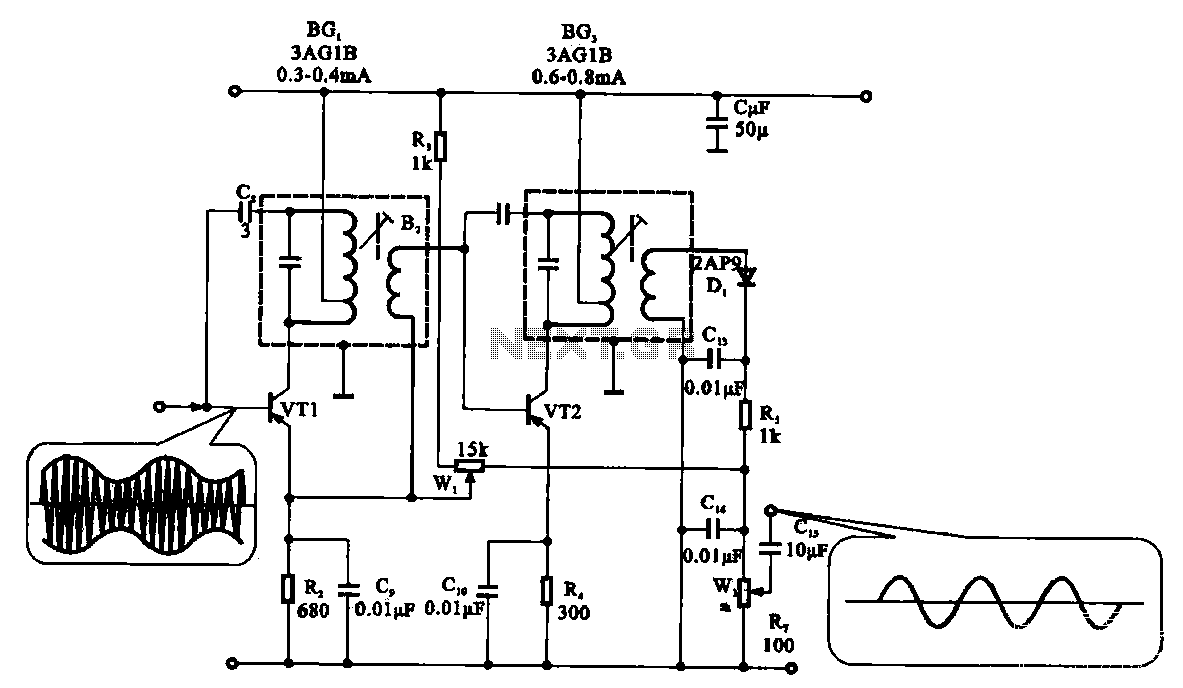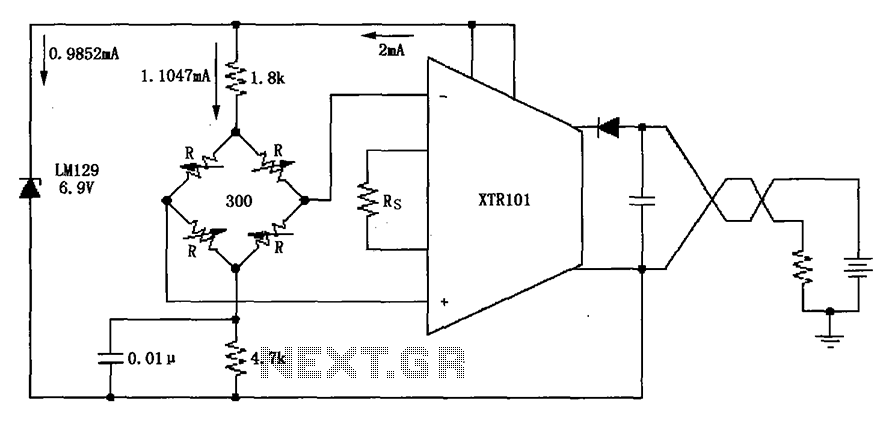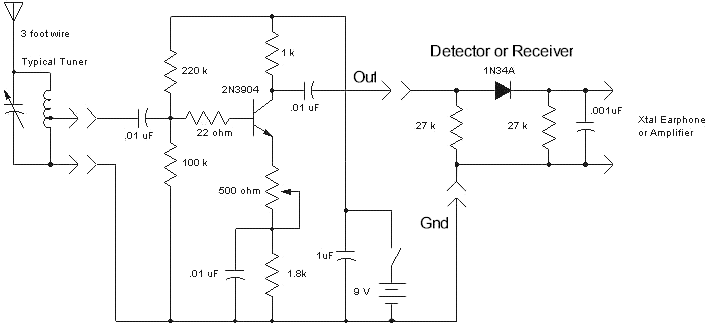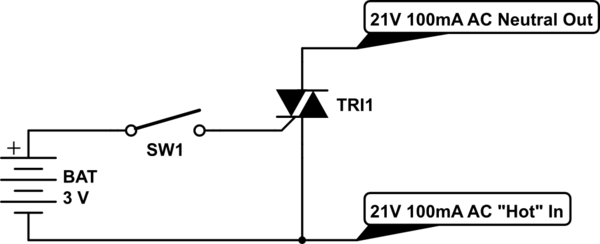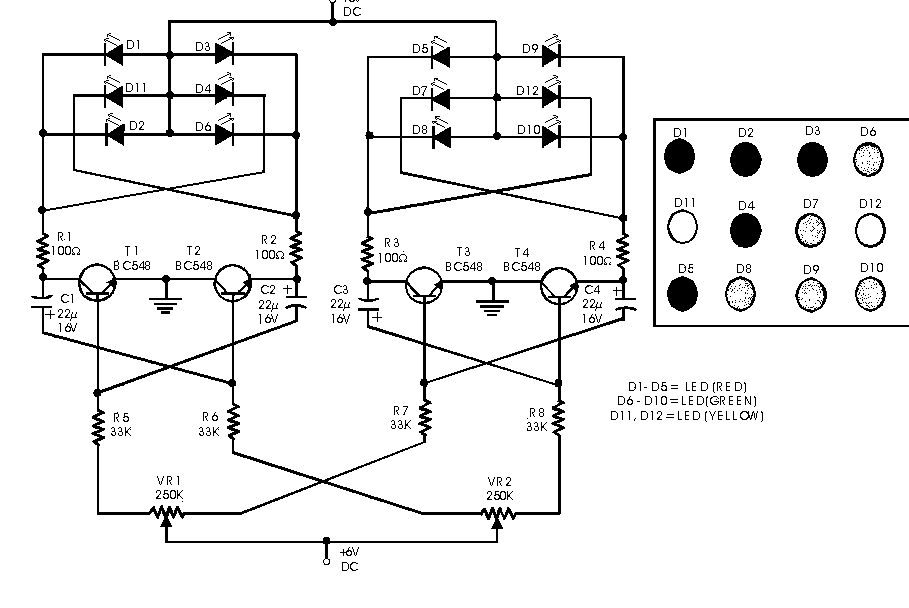
Intelligent ultrasonic ranging ASIC SB5227 peripheral circuit design

The SB5227 ultrasonic signal output is very weak and must be amplified via a power amplifier for effective transmission. A typical transmission circuit is illustrated in the accompanying figure. The SB5227 ultrasonic signal is sourced from output pin 10, which is buffered by amplifier F (VT1, VT2) to drive the transmitter. Low-power transistors VT1 and VT2 can be replaced with power FETs. The receiver circuit comprises six main components: an input protection circuit (C1, R1, VD1, and VD2); an impedance matching and current amplifier (VT1); two voltage amplifiers (VT2, IC1); a band-pass filter (L1, C6); an output-stage amplifier (VT3); and a voltage comparator (IC2). C1 serves as a DC blocking capacitor, while R1 acts as a current limiting resistor. VD1 and VD2 form a bidirectional overvoltage limiter circuit. J-FETs are required for VT1, while low-power transistors are suitable for VT2 and VT3. IC1 is a TL061 single op-amp, and IC2 is a quad voltage comparator, LM339. The band-pass filter's center frequency should align with the receiver's center frequency. An adjustment potentiometer, RP, can modify the receiver's sensitivity and enhance its anti-jamming capabilities. Under normal conditions, IC2 outputs high; upon detecting the first rising edge of the ultrasonic burst, the output switches low, causing the SB5227 to halt the internal timer at pin 8. The technical specifications necessitate a more advanced reception circuit, which may also incorporate automatic gain control (AGC) and an automatic search window circuit.
The SB5227 ultrasonic signal transmission and reception system is designed to optimize the performance of ultrasonic applications. The weak output signal from the SB5227 necessitates the use of a power amplifier to ensure sufficient transmission strength. The circuit begins with the ultrasonic signal generated at output pin 10, which is first buffered by a pair of amplifying transistors (VT1 and VT2). These transistors can either be low-power types or replaced with power FETs depending on the design requirements.
The receiver circuit is critically structured to enhance signal integrity and reliability. It starts with an input protection circuit comprising a DC blocking capacitor (C1), a current limiting resistor (R1), and two diodes (VD1 and VD2) which together form a bidirectional overvoltage protection mechanism. This ensures that the circuit remains safe from voltage spikes that could damage sensitive components.
Following this, the impedance matching and current amplification stage utilizes VT1, which is specifically selected as a J-FET to maximize performance. The voltage amplification stage involves VT2 and an operational amplifier (IC1, TL061), which provides additional gain to the received signal. The band-pass filter (L1, C6) is essential for isolating the desired frequency range, ensuring that the system is tuned to the same center frequency as the ultrasonic signal being transmitted.
The output-stage amplifier (VT3) further amplifies the filtered signal before it is processed by the voltage comparator (IC2, LM339). This comparator plays a crucial role in signal detection, toggling its output based on the presence of an ultrasonic burst. The system features an adjustment potentiometer (RP) that allows for fine-tuning of the receiver's sensitivity, enhancing its ability to reject noise and improve overall performance.
In terms of operational behavior, the circuit is designed to maintain a high output from IC2 during normal operation. When the first rising edge of the ultrasonic signal is detected, IC2's output transitions low, which signals the SB5227 to stop the internal timer at pin 8, effectively marking the start of the signal processing sequence.
To meet advanced technical requirements, the circuit may also be equipped with additional features such as automatic gain control (AGC) and an automatic search window circuit, which further enhance the system's responsiveness and adaptability in varying operational environments. Overall, this comprehensive design facilitates effective ultrasonic communication while ensuring robust signal processing capabilities.SB5227 ultrasonic signal output is very weak, it must be sent to the drive via the power amplifier. A typical transmission circuit as shown in FIG. SB5227 ultrasonic signal from the output pin 10, and a buffer amplifier F (VT1, VT2) drive transmitter. Using low-power transistors VT1, VT2 optional power FET. The receiver circuit includes the following six parts: input protection circuit (C1, R1, VD1 and VD2); impedance matching and current amplifier (VT1); two voltage amplifier (VT2, IC1); band-pass filter (L1, C6) ; output-stage amplifier (VT3); a voltage comparator (IC2).
C1 is a DC blocking capacitor, R1 is a current limiting resistor. VD1 and VD2 constitute bidirectional overvoltage limiter circuit. VT1 requires the use of J-FET, VT2 and VT3 selection of low-power transistors. IC1 is TL061 single op amp, IC2 is Quad voltage comparator LM339 (now only the way in which). Bandpass filter center frequency should be the same as the center frequency of the receiver. Adjustment potentiometer RP can change the receiver sensitivity, improve anti-jamming capability. Under normal IC2 output high, when receiving the first rising edge of the ultrasonic burst on output low, the SB5227 to the 8 feet, so that the internal timer is stopped counting. The technical conditions require a higher reception circuit, but also increase automatic gain control (AGC), automatic search window circuit.
The SB5227 ultrasonic signal transmission and reception system is designed to optimize the performance of ultrasonic applications. The weak output signal from the SB5227 necessitates the use of a power amplifier to ensure sufficient transmission strength. The circuit begins with the ultrasonic signal generated at output pin 10, which is first buffered by a pair of amplifying transistors (VT1 and VT2). These transistors can either be low-power types or replaced with power FETs depending on the design requirements.
The receiver circuit is critically structured to enhance signal integrity and reliability. It starts with an input protection circuit comprising a DC blocking capacitor (C1), a current limiting resistor (R1), and two diodes (VD1 and VD2) which together form a bidirectional overvoltage protection mechanism. This ensures that the circuit remains safe from voltage spikes that could damage sensitive components.
Following this, the impedance matching and current amplification stage utilizes VT1, which is specifically selected as a J-FET to maximize performance. The voltage amplification stage involves VT2 and an operational amplifier (IC1, TL061), which provides additional gain to the received signal. The band-pass filter (L1, C6) is essential for isolating the desired frequency range, ensuring that the system is tuned to the same center frequency as the ultrasonic signal being transmitted.
The output-stage amplifier (VT3) further amplifies the filtered signal before it is processed by the voltage comparator (IC2, LM339). This comparator plays a crucial role in signal detection, toggling its output based on the presence of an ultrasonic burst. The system features an adjustment potentiometer (RP) that allows for fine-tuning of the receiver's sensitivity, enhancing its ability to reject noise and improve overall performance.
In terms of operational behavior, the circuit is designed to maintain a high output from IC2 during normal operation. When the first rising edge of the ultrasonic signal is detected, IC2's output transitions low, which signals the SB5227 to stop the internal timer at pin 8, effectively marking the start of the signal processing sequence.
To meet advanced technical requirements, the circuit may also be equipped with additional features such as automatic gain control (AGC) and an automatic search window circuit, which further enhance the system's responsiveness and adaptability in varying operational environments. Overall, this comprehensive design facilitates effective ultrasonic communication while ensuring robust signal processing capabilities.SB5227 ultrasonic signal output is very weak, it must be sent to the drive via the power amplifier. A typical transmission circuit as shown in FIG. SB5227 ultrasonic signal from the output pin 10, and a buffer amplifier F (VT1, VT2) drive transmitter. Using low-power transistors VT1, VT2 optional power FET. The receiver circuit includes the following six parts: input protection circuit (C1, R1, VD1 and VD2); impedance matching and current amplifier (VT1); two voltage amplifier (VT2, IC1); band-pass filter (L1, C6) ; output-stage amplifier (VT3); a voltage comparator (IC2).
C1 is a DC blocking capacitor, R1 is a current limiting resistor. VD1 and VD2 constitute bidirectional overvoltage limiter circuit. VT1 requires the use of J-FET, VT2 and VT3 selection of low-power transistors. IC1 is TL061 single op amp, IC2 is Quad voltage comparator LM339 (now only the way in which). Bandpass filter center frequency should be the same as the center frequency of the receiver. Adjustment potentiometer RP can change the receiver sensitivity, improve anti-jamming capability. Under normal IC2 output high, when receiving the first rising edge of the ultrasonic burst on output low, the SB5227 to the 8 feet, so that the internal timer is stopped counting. The technical conditions require a higher reception circuit, but also increase automatic gain control (AGC), automatic search window circuit.
